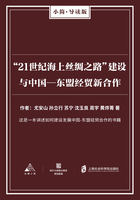Different times,different problems.Beginning in the1990s,the sticking point with state enterprises no longerconcerned assets——there was hardly any value left todepreciate——but that state employees cannot be dis-charged under law.Nevertheless,large-scale privatiza-tion of loss-making state enterprises was successfullycarried out around the turn of the century,effectivelyassisted by a substantial rise in land prices.We shallexplain what happened later.
An idea of great value was salvaged fromthe disap-pointing experience of the responsibility contract in theindustrial sector.Around 1984,a layer-by-layer respon-sibility arrangement emerged.In essence this was sub-contracting,and we know in industry how the “subs”may go down a number of layers in a chain.If we must single out one key development in China’s economicreform,then my choice is that beginning from the late1980s responsibility contracts in agriculture was com-bined with the layer-by-layer responsibility arrangementsin industry.This is a truly significant achievement,because the combination was applied neither to individ-ual farms nor individual state-owned enterprises,but toentities defined by geographic boundaries.In my view,this is the central feature of the economic systemofChina today.
For someone following the day-to-day development of this system he might find it very complex,but when the changes finally settle down and one is able to put the pieces together,the system is seen to be straightforwardand rational.What happened has not been tried anywherebefore.Although none of the parts are new,the way they are put together is original and effective.During the early application of responsibility contract combinationsto localities,the arrangements differed in different placesand changes were frequent,until around 1994 the com-mon features of the whole became identifiable.I came toappreciate that there was something truly special about the system when I looked into the development ofKunshan in 1997.The intensity of competition amonglocalities then was something I had never seen before.When deflation ended around 2000,locality competitionbecame so dynamic that I did not fully decipher the work-ings until the end of 2004.It is true that in varyingdegrees,competition among localities also exists in other countries,but as we shall see,both in nature and in inten-sity,what is observed in China has no equal elsewhere.
Although many of the people involved were very capable,I do not believe that the system of China nowinplace is the result of brilliant individual efforts.The sys-temas it stands today is rather the result of economicpressures,with many mouths to feed and the rising tidewas roaring.To handle the situation,the guiding princi-ple followed was not the popularly quoted saying of Deng Xiaoping——“feel the stones when crossing theriver,” but that the man of few words said: “Give it a try,and then take a look.”
Let me begin the description of the locality-competingsystemby clearing up a matter of terminology.Each and every locality of course has a proper name,but theircommon names——whether city or town——are of tenconfusing.Some of the common names are different because they were coined at different times,and to days ome localities are specially treated because they reportdirectly to Beijing.I prefer my way of classifying locali-ties,which is generally endorsed by official friends.
It is instructive to view China as consisting of sevenlayers,all geographically determined,with a lower layerfalling inside the confines of the layer above.The to player is the country,then comes the provinces,the cities,the xians,the towns,the villages,and finally the house-holds.These seven layers are linked vertically byresponsibility contracts,but horizontally there are no con-tractual linkages.Competition therefore occurs horizon-tally but not vertically.Entities bearing similar responsi-bilities compete against one other,within the same layer.
The intensity of locality competition varies positivelywith economic power assigned to each layer.Today,economic power by and large rests in the xians.Thechief economic power does not rest in the villages ortowns or cities or provinces or even Beijing but in the xians,for the reason that xians possess the right to decideand allocate the use of land.The central government in Beijing(and to a lesser extent the provincial authorities)reserve the right to define and enforce general guidelinesregarding land use and other general economic and polit-ical matters.They also possess the right to shift the geo-graphic boundaries of localities,to fire or reshuffle localofficials,and to reallocate funds to assist localities undercertain conditions.
The right to decide and allocate land use is the key issue in a developing country.Without landthere wouldbe nothing to develop,and if land is used efficiently allother considerations become secondary.If under compe-tition land rents are rising,the economy is growing.Technology change and the accumulation of physicaland human capital are no doubt important,and the coun-try is marching forward in these areas——right now,the growth rate of private R&D expenditure in China is thehighest in the world.But technology and investmentwould be of little effect when people do not have enoughto eat.Take care of land use,lift the masses fromstarva-tion,and then the economy can take off with the supportof saving,investment and technological change.














